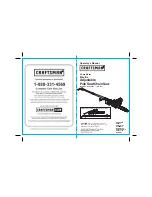
17
16
ASSEMBLY & ADJUSTMENTS
The pole saw/chain saw is intended for wood: sawing of trees, tree trunks, branches,
wooden beams, planks, etc. Cuts can be sawed with or across the grain.
This product is not suitable for sawing mineral materials, plastics or non-wood building materials.
INTENDED USE
CHAIN AND CHAIN BAR ASSEMBLY/REPLACEMENT
(See Figs. 3a, 3b, 3c, 3d, 3e and Pgs 14-15 for part reference)
CHAIN AND CHAIN BAR
ASSEMBLY/REPLACEMENT cont.
ASSEMBLY & ADJUSTMENTS cont.
WARNING:
Do not connect the chain saw to extension cord and power source
before it is completely assembled. Always use gloves when handling the chain.
!
WARNING:
The chain is not yet tensioned. Tensioning the chain applies
as described under “TENSIONING CHAIN”. The chain now needs to be inspected
to make sure it is properly tensioned.
!
Fig. 3b
1. Place the chain saw on any suitable flat surface.
2. Slide the Chain
(
10
)
in the slot around the Guide Bar (9). Ensure the Chain
is in correct running direction by comparing it to the Chain Direction Symbol (16) found
on the saw body. Ensure the Bar Tensioning Plate (22) is facing outwards. (Fig. 3a).
3. Fit the Chain onto the Drive Sprocket (15), so that the Fastening Bar Bolt (19) and the
two Bar Locating Tabs (20) on the Bar Clamp (18) fit into the keyway of the opening
on the Guide Bar (9), (See Fig. 3b).
4. Check to make sure all parts are seated
properly and hold chain and guide bar in
a level position. (See Fig. 3c)
5. Fit the Chain Cover (12) (pg. 15, Fig. 1),
and tighten the Chain Cover by turning the
Chain Tensioning Knob (11) clockwise until
it is tight. (pg. 15, Fig. 1),
ASSEMBLY
Fig. 3a
Fig. 3c
Fig. 3d
WARNING:
Unplug chain saw from
power source before adjusting saw chain
tension.
!
WARNING:
Cutting edges on chain
are sharp. Use protective gloves when
handling chain.
!
WARNING: ALWAYS
Maintain proper chain tension. A loose chain will
increase the risk of kickback. A loose chain may jump out of guide bar groove.
This may injure operator and damage chain. A loose chain will cause chain, chain
bar, and sprocket to wear rapidly. The chain life of the saw chain mainly depends
upon sufficient lubrication and correct tensioning. Avoid tensioning the chain if it
is hot, as this will cause the chain to become over tensioned when it cools down.
!
TENSIONING CHAIN/LOCKING KNOB
Always check the chain tension before use,
after the first cuts and regularly during use.
Upon initial operation, new chains can lengthen
considerably.
NOTE: New saw chains will stretch. Check the
chain tension frequently when first used and
tighten when the Chain (10) becomes loose
around the Guide Bar (9). (See Fig. 3e)
1. Place the chain saw on any suitable flat surface.
2. Turn the Chain Tensioning Knob (11) clockwise
until it is hand tight. The tension is automatically
set while the Chain Tensioning Knob is being
tightened.
The ratchet mechanism prevents the chain
tension from loosening.
3. Double check the tension set by the automatic
Chain Tensioning Knob. The correct chain
tension is reached when the Chain (10) can be
raised approx. 0.12– 0.24” (3-6mm) from the
Guide Bar (9) in the center. This should be done
by using one hand to raise the chain against the
weight of the machine. (See Fig. 4)
4. The Chain will stretch from use and lose proper tension.
To turn knob counter clockwise (3x), secure the chain cover, and retension the chain
simply repeat steps 1 - 3 listed above.
10
9
22
20
18
19
15
12
11
6. Press the cover plate firmly onto the
machine and screw on the cover plate (12)
with the locking knob (11). (See Fig. 3d)
Fig. 3e
Fig. 4
0.12-0.24”
(3-6mm)
EN: Bar / F: Bar
ES: Barra de guía
16



































